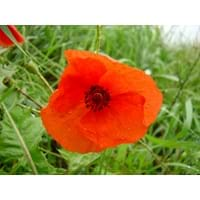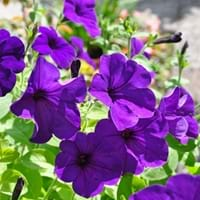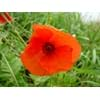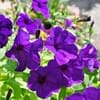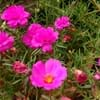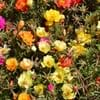Type
Herbs
Flowering Plants, Shrubs
Origin
Europe, Northern Africa, Central Asia, Western Asia
Hybrid origin
Number of Varieties
Not Available
Habitat
Cultivated Beds
Terrestrial
USDA Hardiness Zone
4-8
9-10
AHS Heat Zone
12 - 1
12 - 3
Sunset Zone
A1, A2, A3, 1a, 1b, 2a, 2b, 3a, 3b, 4, 5, 6, 7, 8, 9, 10, 11, 12, 13, 14, 15, 16, 17, 18, 19, 20, 21, 22, 23, 24
A1, A2, A3, H1, H2, 1a, 1b, 2a, 2b, 3a, 3b, 4, 5, 6, 7, 8, 9, 10, 11, 12, 13, 14, 15, 16, 17, 18, 19, 20, 21, 22, 23, 24
Habit
Upright/Erect
Prostrate/Trailing
Flower Color
Red, Orange Red, Black
White, Blue, Purple, Pink, Light Pink, Hot Pink, Magenta, Lavender
Flower Color Modifier
Bicolor
Bicolor
Fruit Color
Sandy Brown, Chocolate
Not Available
Leaf Color in Spring
Light Green, Gray Green
Green
Leaf Color in Summer
Light Green, Gray Green
Green
Leaf Color in Fall
Not Available
Green
Leaf Color in Winter
Light Green
Light Green
Plant Season
Spring, Summer
Spring, Summer, Fall
Sunlight
Full Sun, Partial Sun
Full Sun
Growth Rate
Very Fast
Very Fast
Type of Soil
Loam, Sand
Loam, Sand
The pH of Soil
Neutral
Acidic, Neutral
Soil Drainage
Well drained
Well drained
Bloom Time
Late Spring, Early Summer, Summer
Indeterminate
Tolerances
Drought
Drought
Where to Plant?
Container, Ground, Pot
Container, Ground, Pot
How to Plant?
Seedlings
Seedlings, Transplanting
Plant Maintenance
Medium
Medium
Watering Requirements
Keep ground moist, Keep the Soil well drained, Medium, Requires regular watering
Keep the ground moist but not water-logged, Requires regular watering, Requires watering in the growing season
In Summer
Lots of watering
Lots of watering
In Spring
Moderate
Moderate
In Winter
Average Water
Average Water
Soil pH
Alkaline, Neutral
Neutral
Soil Type
Loam, Sand
Loamy, Sandy
Soil Drainage Capacity
Loam, Moist but well drained
Well drained
Sun Exposure
Full Sun
Full Sun, Partial shade
Pruning
No need to prune, Remove damaged leaves, Remove dead branches, Remove dead leaves
Cut or pinch the stems, Do not prune during shooting season, Remove dead or diseased plant parts, Remove deadheads
Fertilizers
All-Purpose Liquid Fertilizer
All-Purpose Liquid Fertilizer
Pests and Diseases
Adelgids, Downy mildew, Red blotch
Red blotch
Plant Tolerance
Drought
Drought
Flower Petal Number
Single
Single
Foliage Texture
Medium
Medium
Foliage Sheen
Matte
Matte
Attracts
Butterflies
Hummingbirds, Butterflies
Allergy
Headache, Toxic if not prepared properly
Not Available
Aesthetic Uses
Beautification, Cut Flowers, Decorating walls, Hanging Basket, Showy Purposes, Used as an interior landscaping species, Used for decorating walls, fences, gates, hedges, etc.
Beautification, Bouquets, Showy Purposes
Beauty Benefits
Not Available
Not Available
Environmental Uses
Air purification
Air purification
Medicinal Uses
Anodyne, Cancer, Emmenagogue, Emollient, Expectorant, Hypnotic, Sedative, Tonic
Not Available
Part of Plant Used
Flowers, Leaves, Seeds
Flowers
Other Uses
Cake, Cut Flowers, Decoration Purposes, Used for its medicinal properties, Used for making black and brown dye, Used in flavouring curries, teas, Used to flavour soups
Showy Purposes
Used As Indoor Plant
Yes
Yes
Used As Outdoor Plant
Yes
Yes
Garden Design
Cottage garden, Cutflower, Flower borders, Hanging Basket, Showy Tree
Hanging Basket
Botanical Name
PAPAVER rhoeas
PETUNIA 'PAS3187'
Common Name
Corn Poppy, Flanders Field Poppy, Shirley Poppy
Purple Wave Petunia, Spreading Petunia, Wave Purple Petunia
In Hindi
शर्ली अफीम
Purple wave petunia
In German
Klatschmohn
Lila Welle Petunie
In French
shirley pavot
Pétunia pourpre Vague
In Spanish
Shirley amapola
Petunia púrpura Wave
In Greek
Shirley παπαρούνας
Purple Wave πετούνια
In Portuguese
Shirley poppy
Onda roxa do petúnia
In Polish
Shirley maku
Purpurowy fali petunii
In Latin
Shirley, papaveris
Purpura unda Petunia
Phylum
Tracheophyta
Magnoliophyta
Class
Magnoliopsida
Magnoliopsida
Order
Ranunculales
Solanales
Family
Papaveraceae
Solanaceae
Clade
Angiosperms, Eudicots
Angiosperms, Asterids, Eudicots
Tribe
Papavereae
Not Available
Subfamily
Paperveroideae
Petunioideae
Season and Care of Shirley Poppy and Purple Wave Petunia
Season and care of Shirley Poppy and Purple Wave Petunia is important to know. While considering everything about Shirley Poppy and Purple Wave Petunia Care, growing season is an essential factor. Shirley Poppy season is Spring and Summer and Purple Wave Petunia season is Spring and Summer. The type of soil for Shirley Poppy is Loam, Sand and for Purple Wave Petunia is Loam, Sand while the PH of soil for Shirley Poppy is Neutral and for Purple Wave Petunia is Acidic, Neutral.
Shirley Poppy and Purple Wave Petunia Physical Information
Shirley Poppy and Purple Wave Petunia physical information is very important for comparison. Shirley Poppy height is 30.00 cm and width 20.30 cm whereas Purple Wave Petunia height is 10.20 cm and width 90.00 cm. The color specification of Shirley Poppy and Purple Wave Petunia are as follows:
Shirley Poppy flower color: Red, Orange Red and Black
Shirley Poppy leaf color: Light Green and Gray Green
Purple Wave Petunia flower color: White, Blue, Purple, Pink, Light Pink, Hot Pink, Magenta and Lavender
- Purple Wave Petunia leaf color: Green
Care of Shirley Poppy and Purple Wave Petunia
Care of Shirley Poppy and Purple Wave Petunia include pruning, fertilizers, watering etc. Shirley Poppy pruning is done No need to prune, Remove damaged leaves, Remove dead branches and Remove dead leaves and Purple Wave Petunia pruning is done Cut or pinch the stems, Do not prune during shooting season, Remove dead or diseased plant parts and Remove deadheads. In summer Shirley Poppy needs Lots of watering and in winter, it needs Average Water. Whereas, in summer Purple Wave Petunia needs Lots of watering and in winter, it needs Average Water.
